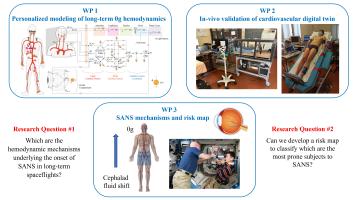Duration: 36 months
Spaceflight Associated Neuro-ocular Syndrome (SANS) is a neuro-ocular disturb comprising a variety of ocular (optic disc edema, globe flattening, choroidal folds, hyperopic shifts) and cerebral (brain upward shift and increased brain ventricular volume) signs, yielding decreased near-visual acuity, visual scotomas and headaches [1, 2]. SANS is classified today among the major 'red' risks of the human space exploration as it represents a maladaptive 0g response, which can become irreversible after long-term spaceflights [3]. Although still under debate, there is growing evidence that cephalad fluid shift is the driving cause of SANS [4]. The complex interplay between long-term spaceflight cardiovascular deconditioning, intracranial pressure increase and fluid redistribution at cerebral-ocular level is actively being investigated but currently unknown [5, 6]. Moreover, even if 70% of astronauts experience inflight SANS signs and symptoms, the inter-subject response is heterogeneous: many astronauts only experience effects in 0g, while in some others changes may be permanent [7]. In this project we propose to build a validated multiscale and personalized digital twin, based on our existing computational framework, to investigate the cardiovascular and ocular hemodynamic response to long-term 0g [8-11]. The objectives are: (i) to understand the hemodynamic mechanisms underlying the onset of SANS in long-term spaceflights; and (ii) to develop a risk map to classify which are the most prone subjects to SANS. Present outcomes will lead to an accurate evaluation of the SANS risk on a wide, heterogeneous, and mixed-gender crew, and will have important implications on the astronaut recruitment and the development of personalized countermeasures. The project will also have a broader impact on the management of future space travelers tourism and for understanding on-Earth aging-associated diseases such as glaucoma, which is the leading cause of irreversible blindness [7, 12].
_____
References:
[1] Lee A. G., Mader T. H., Gibson C. R., Tarver W., Rabiei P., Riascos R. F., et al. Spaceflight associated neuro-ocular syndrome (SANS) and the neuro-ophthalmologic effects of microgravity: a review and an update. npj Microgravity 6, 7 (2020). doi: 10.1038/s41526-020-0097-9
[2] Zhang L.-F., Hargens A.R. Spaceflight-induced intracranial hypertension and visual impairment: Pathophysiology and countermeasures. Physiol. Rev. 98(1), 59-87 (2018). doi: 10.1152/physrev.00017.2016
[3] Patel Z. S., Brunstetter T. J., Tarver W. J., Whitmire A. M., Zwart S. R., Smith S. M., et al. Red risks for a journey to the red planet: The highest priority human health risks for a mission to Mars. npj Microgravity 6, 33 (2020). doi: 10.1038/s41526-020-00124-6
[4] Ong J., Tarver W., Brunstetter T., Mader T. H., Gibson C. R., Mason S. S., et al. Spaceflight associated neuro-ocular syndrome: proposed pathogenesis, terrestrial analogues, and emerging countermeasures. Bri. J. Ophthalmol. 107, 895-900 (2023). doi: 10.1136/bjo-2022-322892
[5] Norsk P. Adaptation of the cardiovascular system to weightlessness: surprises, paradoxes and implications for deep space missions. Acta Physiol. 228, e13434 (2020). doi: 10.1111/apha.13434
[6] Jirak P., Mirna M., Rezar R., Motloch L. J., Lichtenauer M., Jordan J. et al. How spaceflight challenges human cardiovascular health. Eur. J. Prev. Cardiol. 29(10), 1399-1411 (2022). doi: 10.1093/eurjpc/zwac029
[7] Joe, B. Spaceflight associated neuro-ocular syndrome: connections with terrestrial eye and brain disorders. Frontiers in Ophthalmology 4, 1487992 (2024). doi: 10.3389/fopht.2024.1487992
[8] Gallo C., Ridolfi L., Scarsoglio S. Cardiovascular deconditioning during long-term spaceflight through multiscale modeling. npj Microgravity 6(1),27 (2020). doi: 10.1038/s41526-020-00117-5
[9] Fois M., Maule S. V., Giudici M., Valente M., Ridolfi L., Scarsoglio S. Cardiovascular Response to Posture Changes: Multiscale Modeling and in vivo Validation During Head-Up Tilt. Front. Physiol. 13, 826989 (2022). doi: 10.3389/fphys.2022.826989
[10] Fois M., Ridolfi L., Scarsoglio S. In silico study of the posture-dependent cardiovascular performance during parabolic flights. Acta Astronaut. 200, 435-447 (2022). doi: 10.1016/j.actaastro.2022.08.018
[11] Fois M., Diaz-Artiles A., Zaman S. Y., Ridolfi L., Scarsoglio S. Linking cerebral hemodynamics and ocular microgravity-induced alterations through an in silico-in vivo head-down tilt framework. npj Microgravity 10, 22 (2024). doi: 10.1038/s41526-024-00366-8
[12] Flammer J., Orgül S., Costa V. P., Orzalesi N., Krieglstein G. K., Serra L. M. et al. The impact of ocular blood flow in glaucoma. Prog. Retin. Eye Res. 21(4), 359-393 (2002). doi: 10.1016/S1350-9462(02)00008-3

